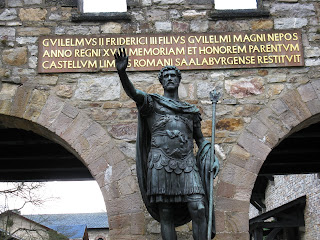
The purpose of this blog is to keep a record of students' academic performance in terms of their research papers, experience-learning projects, and oral presentations.
Since the content will be a little boring, to counter balance, I will insert between the paragraphs pictures of Berliner landmarks made entirely of chocolate!
On November 29, during the last "German-American Cultural Contrast" class, students handed in their papers covered the topic such as German and American Higher Education System; German Immigration; Berlin's Cultural Through Architecture; The Berlin Modernism Housing Estates; Afro-Germans; Free Speech in Germany and the United States.

They also presented their semester project about how they involved themselves with a speaking partner, in a club, in a community, or within a culture center.
Through the semester, students were "forced" to get out of their comfort zone to go to the "field" to reflect on cultural distinctions they encountered and the skills they used to navigate those differences. The experience-learning was an important part of this study-abroad program.
The projects they presented included involvement in a film club, table tennis club, language-exchange club, World Culture House, Catholic church community, host family, and LGBTQ community.

On December 2, students had their last class of "History of the German Language", where they did their presentations about the research papers they had to write. The topics included:
German newspapers and their language differences;
German Shakespeare Society;
The Crusades and their Impacts to the German Language and Literature;
German dialects;
Foreign influences to the German language;
Reformation, Humanism, Renaissance and Enlightenment in Germany;
Nazism and its language;
Yiddish;
Mark Twain and other famous people’s view about the German language; and
German language between BRD and DDR.

The ultimate goal of this "UMD in Berlin" program has been integrating students' study abroad and career planning so that they can put their overseas experience to use in their own fields.
Study abroad is an expensive investment, and hopefully one semester in Berlin can strengthen students' resume to attract their future employers due to the following reasons:
1. They incorporated experiential exercises into blog entries and journal writing to reflect on cultural distinctions.
2. They acquired skills to navigate in a foreign country.
3. By giving multiple oral presentations, they practiced public-speaking skills.
4. They learned to do research in a foreign setting by submitting two term papers.
With this last blog, I wanted to thank all the students in my classes for a wonderful semester. I have learned so much from all of them.






































